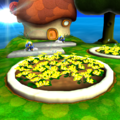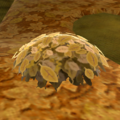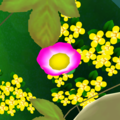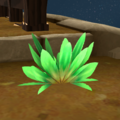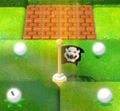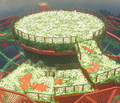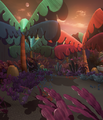Flower (Super Mario series)
- This article is about low-growing plants that conceal items in the Super Mario series. For different subjects of the same name, see Flower.
| Flower | |
|---|---|
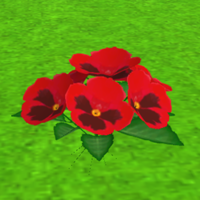 Screenshot from Super Mario Galaxy 2 | |
| First appearance | Super Mario 64 (1996) |
| Latest appearance | Super Mario 3D All-Stars (2020) |
| Effect | Releases concealed items when disturbed |
Flowers[1][2][3] are environmental objects in the Super Mario series. They are low-growing plants that rustle when walked through. Sometimes there are collectible items hidden in flowers. Simply walking through them makes the item pop out. They typically appear in patches or are arranged into flowerbeds[2] (also parsed as flower beds).[1][3] Piranha Plants are often surrounded by these flowers. The form they take and the very plant species they look like are informed by the environment of the level they are found in, but their function remains the same. The most recurring variant is a leafy bush[4] (also called grass[2] or tall grass[5]) introduced in Super Mario Galaxy.
There are examples of flowers as decorative elements throughout the Super Mario franchise that have no interactive qualities. There are other objects localized into English simply as "flowers" (such as a platform in Super Mario Galaxy and a grapple in Super Mario Galaxy 2) in the Super Mario series and even appear within the same games. However, all of these objects have discrete functions and unique names in Japanese.
History
Super Mario 64 / Super Mario 64 DS
Flowers (referred to in at least one instance as tulips)[6] first appear in Super Mario 64, where they grow on the Bob-omb Battlefield and in Whomp's Fortress. Some flower beds release 1-UP Mushrooms when the surrounding coins are collected. Flowers on the Bob-omb Battlefield hide a Warp Point that brings Mario to another flower bed. In the original Nintendo 64 game, all of the flowers are yellow and form hexagonal beds. In Super Mario 64 DS, the flowers are presented as pink, and the beds are more naturally shaped.
Super Mario Galaxy / Super Mario Galaxy 2
In Super Mario Galaxy and Super Mario Galaxy 2, flowers can be found in nearly all levels and now reflect a wider array of species. Flowers that sparkle release Star Bits when walked through. Flowers largely appear in grassy galaxies with visible sunlight, such as Gusty Garden Galaxy and Fluffy Bluff Galaxy. In drab galaxies with minimal light such as the Ghostly Galaxy and Spin-Dig Galaxy, grass appears in place of flowers, serving the same function. There are instances where both flowers and grass can be found, such as Honeyhive Galaxy. Leaf piles appear in place of flowers in Super Mario Galaxy's Gold Leaf Galaxy and fall away when walked through. A small planetoid in Super Mario Galaxy 2's Supermassive Galaxy blooms with many flowers when stepped on and appears in the screenshot awarded to the player once they have collected 120 Power Stars.
Super Mario 3D Land / Super Mario 3D World
Flowers and bushes[4] appear throughout Super Mario 3D Land and Super Mario 3D World. The flowers appear as small clusters of cosmos and come in a variety of colors. In these games, using a move from a power-up (i.e., throwing a boomerang as Boomerang Mario through one or hitting it with a Tanooki's tail) has the same effect as walking through them, usually causing a coin to pop out and immediately be added to the player's total. In some instances, disturbing a flower knocks a Coin Coffer out of hiding or causes a trail of notes to appear.
Little dandelions called Fluffs[7] appear in both games, and they release an item when the player blows into their respective system's microphone. In Super Mario 3D Land, this item is always a Super Mushroom. Because the Nintendo Switch lacks a microphone, the player needs to walk through or hit Fluffs in Super Mario 3D World + Bowser's Fury.
Super Mario Odyssey
Flowers and bushes appear in Super Mario Odyssey. In lieu of power-ups, throwing Cappy at flowers can reveal the hidden item within. Coin piles can pop out of flowers and bushes. A wide variety of plants is introduced to satisfy this gameplay concept while maintaining the intended design of each location. For example, ferns appear in place of flowers in the Cascade Kingdom, and tumbleweeds appear in the Sand Kingdom. In some locations, bushes can be ground-pounded to release individual coins. In the Wooded Kingdom, Steam Gardeners cultivate flowers and are best known for giant white flowers. They are stolen by Bowser during the game.
Gallery
Flowers in Super Mario 64
Flowers in Super Mario 64 DS
Flowers in Super Mario Galaxy
Leaf pile in Super Mario Galaxy
Flowers in Super Mario Galaxy 2
Flowers in Super Mario 3D Land
Flowers in Super Mario 3D World
Fluffs in Super Mario 3D World
Flowers in Super Mario Odyssey
Bushes (Lake Kingdom) in Super Mario Odyssey
Soirée Bouquet in Super Mario Odyssey
Bushes (Lost Kingdom) in Super Mario Odyssey
Bushes (Metro Kingdom) in Super Mario Odyssey
Names in other languages
| Language | Name | Meaning |
|---|---|---|
| Japanese | 草花[8] Kusabana |
usually localized as "flower" and used interchangeably with「花」("hana") by Japanese speakers, but it sometimes more strictly means "of grass and flowers" (with「草」("kusa") meaning grass) or "plants with flowers" in an artistic sense;「草花」is sometimes applied to floral arrangements that include fruits or plants not even capable of flowering |
References
- ^ a b Scott Pelland and Dan Owsen. The Super Mario 64 Nintendo Player's Guide. Redmond: Nintendo of America, 1996. Page 18.
- ^ a b c Fletcher Black. Super Mario Galaxy: PRIMA Official Game Guide (Collector's Edition). Roseville: Prima Games, 2007. Page 41. ISBN: 978-0-76155-713-5.
- ^ a b Catherine Browne. Super Mario Galaxy 2: PRIMA Official Game Guide. Roseville: Random House Inc, 2010. Page 147. ISBN: 978-0-30746-907-6.
- ^ a b Nick von Esmarch. Super Mario 3D Land: PRIMA Official Game Guide. Roseville: Random House Inc, 2011. Pages 52 and 104. ISBN: 978-0-307-89386-4.
- ^ Catherine Browne. Super Mario Galaxy 2: PRIMA Official Game Guide. Roseville: Random House Inc, 2010. Page 36.
- ^ Scott Pelland and Dan Owsen. The Super Mario 64 Nintendo Player's Guide. Redmond: Nintendo of America, 1996. Page 24.
- ^ Nick von Esmarch. Super Mario 3D Land: PRIMA Official Game Guide. Roseville: Random House Inc, 2011. Pages 19 and 125.
- ^ Kazuya Sakai (Ambit), kikai, Akinori Sao, Junko Fukuda, Kunio Takayama, and Ko Nakahara (Shogakukan) (ed.). Encyclopedia Super Mario Bros. (Japanese source). Tokyo: Shogakukan, 2015. Pages 185, 232. ISBN: 978-4-09-106569-8.


